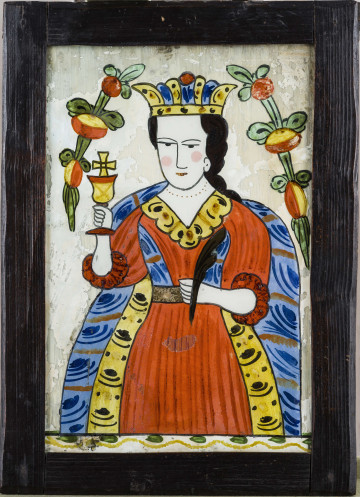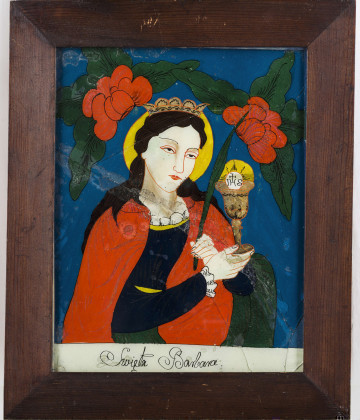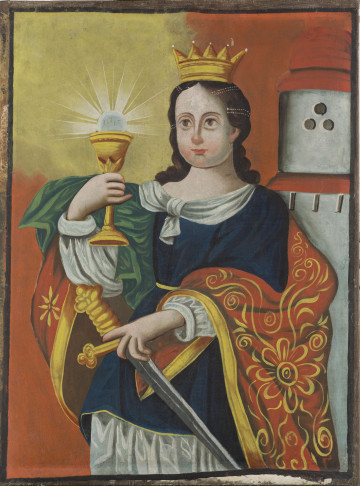
Saint Barbara
1801 — 1900
National Museum in Lublin
Part of the collection: Folk Art of the Lublin Region (17th–1st half of the 20th c.)
The origins of glass painting date to the mid-16th century and are associated with the development of the glass industry and the increasing use of oil paints in painting. In Poland, it became very popular thanks to numerous workshops creating for rural customers. Each developed its own patterns and technique of creating paintings. In the second half of the 19th century this technique did not withstand competition with the rapidly spreading oleo-printingand began to gradually disappear.
Paintings on glass of the Carpathian variety occurred in the area between Zamość, Krosno and Przemyśl. From the artistic and formal point of view they did not form a uniform whole. Like in the Pokuttya variety, they showed affinity with the Western and Eastern European painting. The depictions of St. Nicolas were related to the Orthodox church iconography, representative of the Greek rite of Lemkos living in the area. The western group was connected mainly with the images of the Virgin Mary of Czestochowa, framed in an oval frame characteristic for the old engravings.
Carpathian paintings preserved their individual face – in their composition and decoration there were noticeable connections with folk woodcuts. Probably the local folk woodcut was a direct model for the representation of St. Barbara. Iconographically it is connected to pictures from Slovakia or Pokuttya, where the saint appeared without a tower or a church in the background, although it is her characteristic attribute.
The cult of St. Barbara began to develop in the East from the 6th century, while in the West only from the 13th century. Iconography usually depicts her in a long robe with a belt on her hips, with her head covered, wearing a crown or a cap, holding a chalice with the Host and the sword that killed her, or ostrich feathers symbolising martyrdom. Sometimes she appears with a torch, because, as the legend has it, after the scourging and before the beheading, the torturers also burned her. Sometimes in the background there is a three-windowed tower, in which she was imprisoned.
The cult of Saint Barbara concerned the widely understood sphere of ‘good death’. She was supposed to protect all those working in dangerous professions (miners, sailors, soldiers and prisoners); she took care of them during the plague and protected them from fire and lightning. It was believed that whoever asked her intercession would not die without first making a confession.
Author / creator
Dimensions
cały obiekt: height: 29 cm, width: 37,5 cm
Object type
picture
Material
glass, paint
Creation time / dating
Creation / finding place
Owner
The National Museum in Lublin
Identification number
Location / status

1801 — 1900
National Museum in Lublin

1801 — 1900
National Museum in Lublin

1901 — 1920
National Museum in Lublin
DISCOVER this TOPIC
Castle Museum in Łańcut
DISCOVER this PATH
Educational path